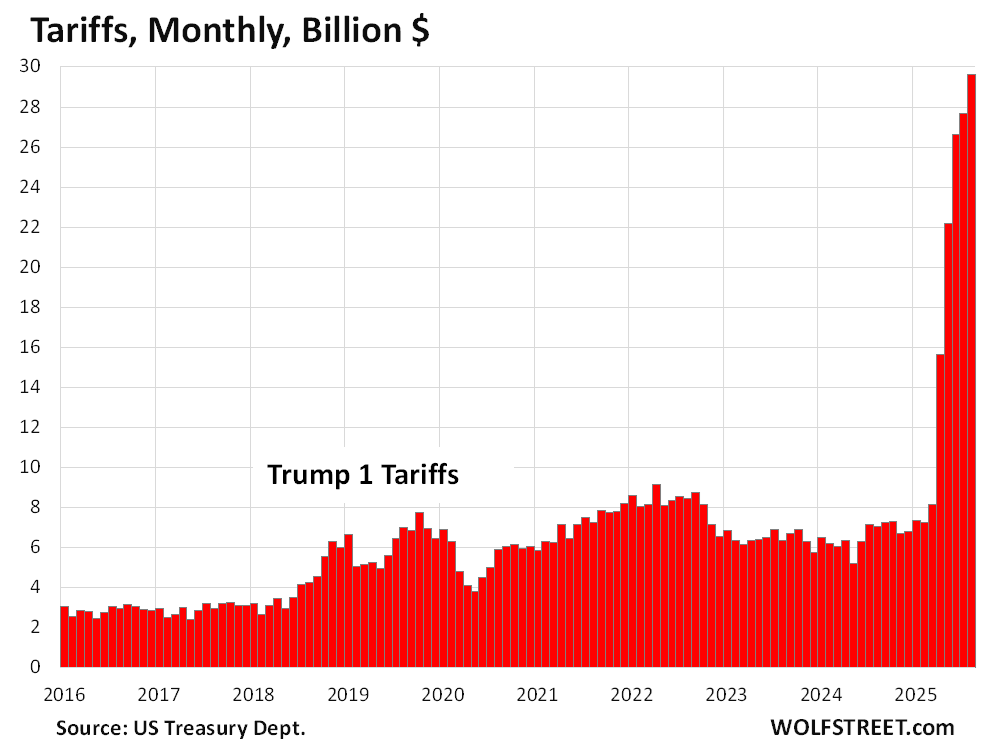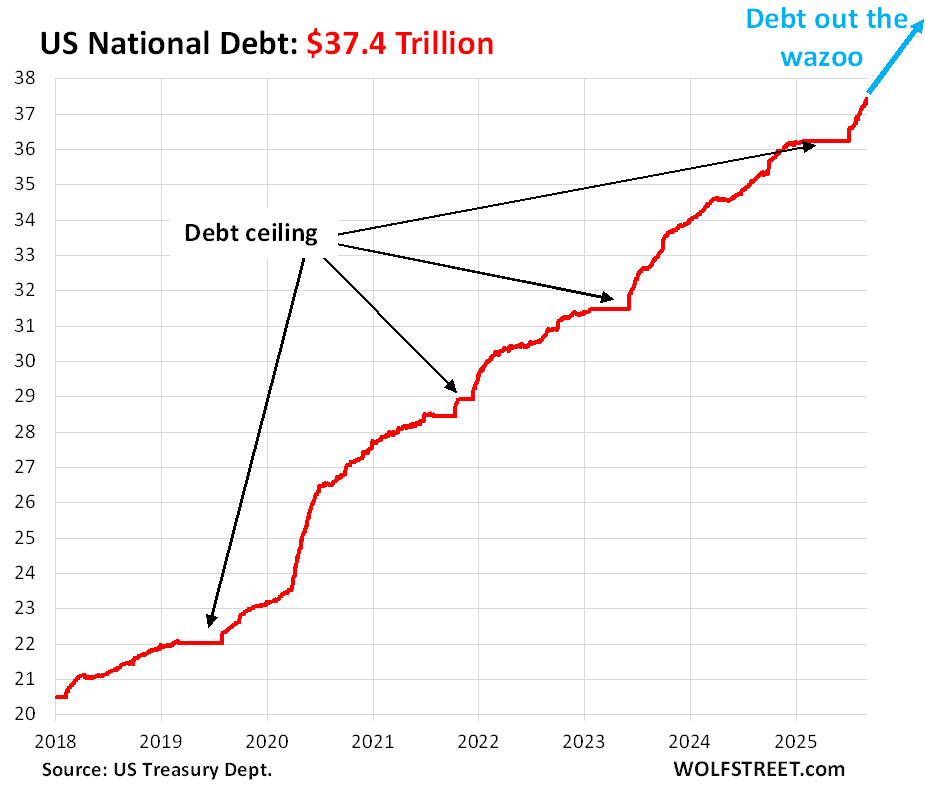A few stupid unelected judges are trying to destroy the U.S. to get at Trump, even though other President had no trouble enacting all the things Trump is trying to do to keep the U.S. strong and free.
Scenario of a Triple Whammy for Long-Term Treasury Yields
by Wolf Richter • Sep 7, 2025 • 3 Comments
The Treasury market counts on the tariffs to slow the supply of new debt and could throw a hissy-fit if they end while the Fed cuts rates into accelerating inflation.
By Wolf Richter for WOLF STREET.
Revenues from tariffs soared to about $30 billion in August. Tariffs have always existed. What’s new is the amount. The new tariffs started taking off in April. Before then, revenues from tariffs amounted to about $7 billion a month. So in August, about $23 billion come from the new tariffs. Revenues from tariffs have increased every month since March.
If revenues from the new tariffs level off at $25 billion a month, they would amount to $300 billion in new revenues a year, and would lower the amount of the would-be annual deficit by $300 billion a year, thereby slowing this Mississippi River of new debt that the market has to absorb.
The Treasury market is counting on this additional revenue to slow the vast supply of new debt that investors have to absorb, amid worries about a lax Fed that is getting ready to cut short-term interest rates despite rising inflationary pressures.

The US gross national debt has soared by $1.2 trillion in the two months since the debt ceiling, and also by that much since the beginning of 2025, to $37.4 trillion currently.
By calendar year, the total Treasury debt increased by:
- $2.2 trillion in 2024,
- $2.6 trillion in 2023.
Obviously, the debt will continue to grow, but the tariffs are slowing that growth and have a chance of slowing the increase of the debt in the calendar year 2025 below the $2 trillion mark – assuming continued economic growth. In a recession, the deficit will blow out because income-tax revenues plunge.

If the new tariffs don’t continue, the Treasury debt would grow by about $300 a year more than it would otherwise, year after year, which would further drive up the interest expense on the debt. Over 10 years, this would amount to $3 trillion in additional debt.
This could happen if the Supreme Court sides with the appeals court’s ruling that the imposition of most of the new tariffs was an illegal use of an emergency powers law, and if then the White House’s “Plan B,” as Bessent called it, fails in reestablishing the tariffs.
Investors have to absorb this Mississippi River of new Treasury debt flowing into the bond market. To accomplish this, new funds need to be enticed into the market, and if they’re worried about inflation and about this Mississippi River of new debt, investors would require more attractive yields to be enticed into this market – meaning higher yields.
And those new tariffs are the only thing currently reducing the flow of the Mississippi River of new debt.
Last week, the Treasury market took comfort in the labor market data. Employers added only 22,000 nonfarm jobs in August, June was revised to a net decline of 13,000 jobs, and July was revised up to a net gain of 79,000 jobs.
Without the 28,000 job losses at federal and state governments, the remaining employers added 50,000 jobs in August and 144,000 jobs over the past three months. So it was slow job growth, dragged down further by continued government job losses. And the unemployment rate rose to 4.3%, still historically low, but up from the range of 4.0% to 4.2% over the prior 14 months [more in My Thoughts about that August Jobs Report].
In response, long-term yields fell across the board, with investors expecting slowing economic growth and lower rates. Over the last two days of the week, the 10-year Treasury yield fell by 14 basis points to 4.08%.
The low point in the 10-year Treasury yield in 2024 was September 16, on the eve of the FOMC rate-cut decision, when it dropped to 3.62%.
The rate cut announcement then caused the 10-year yield to rise, and by mid-January 2025, it had risen by 118 basis points to 4.80%, on fears of a lax Fed amid accelerating inflation, which taught the Fed a lesson, and it put further rate cuts on ice, and replaced them with hawkish talk. The 10-year yield then stared declining again. But this will be changing under Trump’s push for lower short-term rates.

This week, two big inflation reports for August will be released: PPI and CPI. The last inflation reports were bad, with core services inflation sharply accelerating in the CPI, the PPI, and the Fed-favored PCE price index (my analysis for each: CPI, PPI, and PCE).
If core services inflation continues to act up in the PPI and CPI this week and later this year, the bond market is faced with rate cuts amid accelerating inflation – the same scenario that played out in September through December 2024, when the Fed cut by 100 basis points and the 10-year Treasury yield rose by 118 basis points.
But this time, a third element could be on the table: the loss of revenues from the tariffs – in addition to a lax Fed and accelerating inflation.
Tariffs are slowing that river of new debt, and the Treasury market is relying on it to continue, and these new revenues have helped keep a lid on long-term yields in recent months.
But if the revenues from the new tariffs don’t continue, and the supply of new debt therefore increases, while the Fed cuts short-term rates amid accelerating inflation, the Treasury market could throw a real hissy-fit. |







